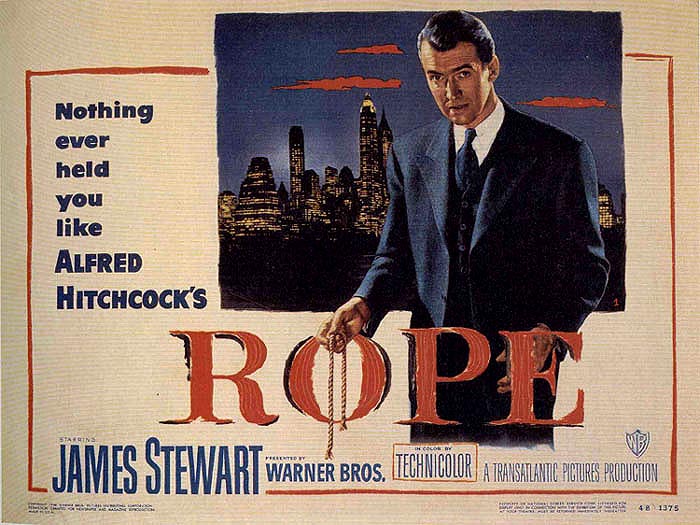 |
| Fig.1 Theatrical Poster |
Hitchcock said that the reason he confined himself to a single shot was to emphasise the fact that the action occured in "real time"; he believed that, like the play the screenplay was based on, if there were any jumps in the action then there would be no suspense - the possibility would have been raised that the body might have been moved when the audience couldn't see it (Ebert, 1984).
At the time of its release, many reviews were critical of its "slow" pace and lack of interest, with the New York Time review observing that "...the tedium of waiting or someone to open that chest and discover the hidden body...(and)...the unpunctuated flow of image becomes quite monotonous." (Crowther, 1948). Even Hitchcock expressed reservations about the film, describing it as "An experiment that didn't work out" (Ebert, 1984), while some questioned his basic premise, pointing out that several contemporary films had successfully conveyed the idea of "real time" action despite using cuts.
However, when the film was re-released in 1984, it recieved a considerably more favourable reception, with reviews lauding Hitchcocks slow and masterful creation of tension. The New York Times review of the re-release stated that ""Rope" is not merely a stunt that is justified by the extraordinary career that contains it, but one of the movies that makes that career extraordinary. (Canby, 1984)
One of the most important "unseen" parts of the film is the set that was constructed for it - Due to the size and bulk of the camera, every part of the set (including the walls) had to be movable so that the camera could move freely around. An army of stagehands was employed to quickly (and most importantly silently) move objects into and out of position. This enabled Hitchcock to move the camera around in a manner that seems almost random, but always seems to be focused on exactly the right piece of action. This is most noticable during the shot of the housekeeper clearing away the food from on top of the chest containing the body - at first this appears to be a secondary action to the conversation occurring camera right, but as the camera stays fixed on her back and forth between the lounge and the kitchen, the tension slowly builds as she gets closer and closer to the moment of opening the chest.
Figure. 1 Warner Bros. Pictures (Org) (1948) "Rope" Theatrical Poster [Digital Image] At: http://www.chasingthefrog.com/ClassicPosters/Alfred_Hitchcock/Rope/rope4.jpg (Accessed on 07/02/2011)
Figure. 2 Warner Bros. Pictures (Org) (1948) "Rope" [Film Still] At: http://theseventhart.files.wordpress.com/2010/04/rope.jpg (Accessed on 08/02/2011)
Bibliography
Canby, Vincent (1984) "Rope": A Stunt to Behold In: The New York Times [Online] At: http://www.nytimes.com/library/film/060384hitch-rope-reflection.html (Accessed on 07/02/2011)
Crowther, Bosley (1948) "Rope": An Exercise in Suspense Directed by Alfred Hitchcock In: The New York Times [Online] At: http://www.nytimes.com/library/film/081748hitch-rope-review.html (Accessed on 07/02/2011)
Ebert, Roger (1984) Rope In: rogerebert.com [Online] At: http://rogerebert.suntimes.com/apps/pbcs.dll/article?AID=/19840615/REVIEWS/811069998/1023 (Accessed on 07/02/2011)
TimeOut Staff (1948) Rope (1948) In: TimeOut London [Online] At: http://www.timeout.com/film/reviews/76944/rope.html (Accessed on 07/02/2011)


No comments:
Post a Comment